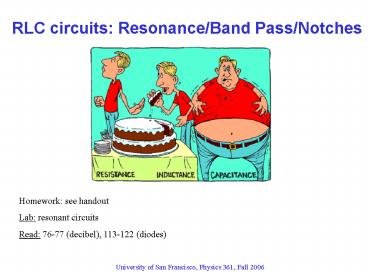RLC circuits: ResonanceBand PassNotches - PowerPoint PPT Presentation
1 / 26
Title:
RLC circuits: ResonanceBand PassNotches
Description:
University of San Francisco, Physics 361, Fall 2006. RLC circuits: Resonance/Band Pass/Notches ... De-energizing - inductive transients. t. t. 0. 0 ... – PowerPoint PPT presentation
Number of Views:232
Avg rating:3.0/5.0
Title: RLC circuits: ResonanceBand PassNotches
1
RLC circuits Resonance/Band Pass/Notches
Homework see handout Lab resonant
circuits Read 76-77 (decibel), 113-122 (diodes)
2
Review Impedance diagram (complex plane)
Im
Re
?
90
3
Impedance diagram (complex plane)
4
Review High pass filter-analysis
Now we can look at the voltage divider equation
with impedances.
Gain
Gain Magnitude
Phase
Lets plot gain and phase vs. frequency, (this is
called the frequency response)
5
Review Gain and phase for high pass filter
Gain Magnitude
The Gain is 0.707 (1/?2) at fc 1/(2?RC)
The phase shift is 45º at fc 1/(2?RC)
6
Inductors - how do they work?
7
Induced voltage induction
- Faradays Law voltage is induced in a circuit
- whenever the flux linking the circuit is
changing. - The magnitude of the voltage is proportional
- to the rate of change of flux
- Lenzs Law the polarity of the induced voltage
- (known as the counter emf or back emf) is
- such as to oppose the cause producing it.
8
Self - inductance
- Induced voltage across
- the coil is
- Approximate inductance
- of coil (when l/d gt 10) is
Units Henry H, ? permeability
9
Series parallel inductances
(networks of inductors can be treated like
resistors)
10
Inductors - how do they work?
11
Inductors - how do they work?
- assume initially no current
- hook up battery L resistant to flow of current
(back emf) - gradually current increases to maximum value V0/R
- voltage across L goes to zero
- note in reality L has a finite resistance (a
long wire)
L
Lets verify this mathematically
12
Inductors - time constant L/R
VR
V0
VL
Again there is a fundamental time scale set by ?
L/R, which has units of seconds (Henry/Ohm)
Lets plot I and VL
13
Current buildup transient in inductor
close the switch
t
0
transient
steady
-
interval
state
t
0
14
Transient steady states of inductor
- Transient interval
- At the instant of closing the switch VL V0
IL 0 Inductor looks like open circuit. - The inductor voltage drops exponentially at the
same time that the inductor current builds up. - inductive transients (like capacitive transients)
last for about 5 time constants. - Steady state
- VL 0, and IL V0/R Inductor looks like a
short.
15
De-energizing - inductive transients
t
0
- An inductor with an initial current looks like a
current source at the instant of switching.
t
0
16
Preventing voltage flashover
- Abruptly breaking the current through a large
inductor (such as a motor or generator field
coil) can cause voltage spikes up to several
thousand volts that will cause a flashover across
the switch. - To prevent a flashover or inductive kick, a
discharge resistor or diode is used.
17
Impedance for an inductor
Lets analyze the circuit with an AC source V0
(t) V0cos?t
For a resistor we found
From the relationship for an inductor
after integration
From the Eulers formula we found
Comparing with the expression for the resistor,
the inductor looks like an effective resistance
or impedance of ZL i?L (in the complex plane it
is 90 degrees ahead of the real resistance)
18
RLC circuits with sinusoidal sources
The AC analysis of circuits with inductors is
also easy, with the effective resistance
(impedance) of an inductor equal to i?L. From a
phasor point of view this means that the inductor
leads the resistor by 90 degrees.
High pass and low pass filters can be made from
inductors as well. However the inductors are
usually bulkier and relatively expensive compared
to capacitors (and more difficult to make in an
integrated circuit) so are not used as commonly.
Another limitation is that they are far from
ideal. The impedance is usually RLi?L, which
means that in order to find the breakpoint you
use
19
Notch and band pass
A notch or band pass filter can serve to select
or eliminate a narrow band of frequencies.
Examples are radio (select) and parental control
channel eliminator circuits.
tune your radio
notch
band pass
88.5 public radio
104.5 K-fog
How do we build these filters?
20
Mathematical analysis of a series LRC circuit -
band pass filter
First find the total impedance of the circuit
Vout
How does Ztotal look in the complex plane?
21
Impedance diagram
(amplitude)
Phase
22
Mathematical analysis of a series LRC circuit -
band pass filter
Using the voltage divider relation we can find
the gain (or transfer function)
The magnitude of the gain is
Note that for high frequencies ?L is dominant and
the gain is R/(?L) or small. At low frequencies
the gain is ?RC because the impedance of the
capacitor is dominant. At ?02 1/(LC) the gain
is one (assuming ideal components) - this is the
resonance condition.
23
Graphing for a series LRC circuit
f0
For LRC circuits it is more typical to plot the
gain as shown on a semi-log graph, since this
emphasizes the peak.
On resonance
(Thomson)
24
Q factor for a series LRC circuit
The quality factor Q is defined as the energy
stored divided by the energy loss/cycle. For an
electronic band pass it is the peak frequency
divided by the bandwidth of the peak (defined by
the frequencies where the gain is 3dB lower than
the maximum or equal to 0.7071/?2)
to find the bandwidth
Solve
or
Then
25
Parallel LRC circuit notch filter
Magnitude
Measured across the resistor, this circuit is a
notch filter, that is it attenuates a small band
of frequencies. The bandwidth in this case is
defined by 3dB from the lowest point on the graph.
26
Parallel LRC circuit notch filter (2)































